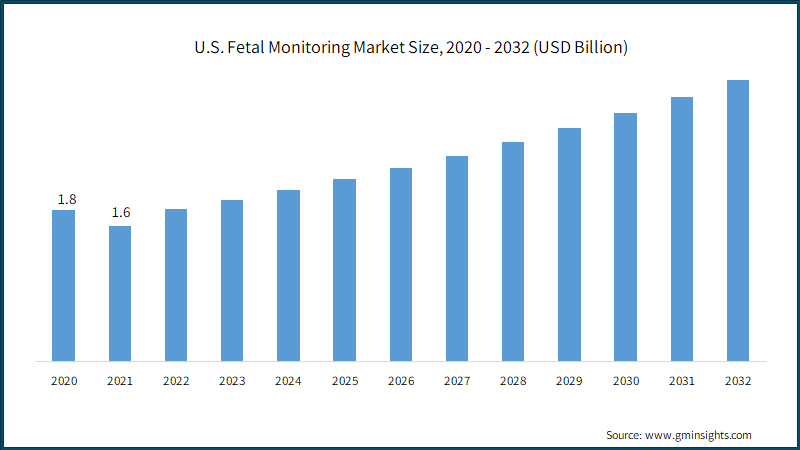Home > Healthcare > Medical Devices > Diagnostic Devices > Fetal Monitoring Market
Fetal Monitoring Market Analysis
- Report ID: GMI6841
- Published Date: Oct 2023
- Report Format: PDF
Fetal Monitoring Market Analysis
The fetal monitoring market by product type is categorized into ultrasound devices, electronic fetal monitoring (EFM), uterine contraction monitor, accessories and consumables, and others. The ultrasound devices segment is further divided into 2D ultrasound, 3D and 4D ultrasound, and doppler imaging. Furthermore, the electronic fetal monitoring (EFM) segment is further bifurcated into external EFM and internal EFM.
The ultrasound devices segment garnered over USD 2.7 billion revenue size in the year 2022. The dominance of the segment can be attributed to its remarkable accuracy, versatility, and safety. Ultrasound technology provides real-time visualization of the fetus, monitors heart rates, and assesses movements with precision, making it a preferred choice for healthcare providers. Furthermore, its non-invasive nature ensures the safety of both the mother and the fetus, while early detection of abnormalities and complications facilitates timely interventions.
Moreover, ultrasound's clinical utility spans routine check-ups to high-risk pregnancies, enhancing its indispensability. Continuous technological advancements, including 2D, 3D, and 4D ultrasound, further solidify its position as the dominant and preferred tool for fetal monitoring.

Based on portability, the fetal monitoring market is segmented into portable and non-portable. The portable segment is predicted to grow at 6.8% CAGR over the analysis timeframe. Portable fetal monitoring devices excel in accessibility and mobility, enabling healthcare providers to perform assessments in various settings, including patients' homes and outpatient clinics. This flexibility enhances patient convenience by reducing the need for frequent facility visits, making prenatal care more accessible and convenient
Moreover, these devices facilitate remote monitoring, enabling healthcare providers to track fetal health from a distance, a crucial feature during the COVID-19 pandemic. Additionally, portable devices offer cost-effective solutions for healthcare facilities and continue to evolve with technological advancements, enhancing their efficiency and user-friendliness, thereby solidifying their dominance in the market.
Based on method, the fetal monitoring market is segmented into invasive and non-invasive. The non-invasive segment dominated the market and accounted for more than 75% market share in the year 2022 and is anticipated to witness the highest growth during the forecast period. Non-invasive methods such as external electronic fetal monitoring (EFM) offer a safe and comfortable monitoring experience for expectant mothers, eliminating the need for invasive procedures and the associated discomfort and risks.
Furthermore, non-invasive methods stand out for their ability to minimize the risk of infection, a critical consideration during pregnancy. Moreover, these methods are widely adopted as the standard for routine prenatal care, facilitating their widespread use in healthcare settintheirhere user-friendly technology and cost-effectiveness make them an economically viable choice for healthcare facilities. Therefore, these combined attributes have solidified the non-invasive segment's dominance in the market, positioning it as the preferred method for monitoring fetal well-being during pregnancy.
The fetal monitoring market by end-use is categorized into hospitals, specialty clinics, and others. The hospital segment is estimated to grow substantially to reach over USD 5.2 billion revenue size by the end of 2032. The dominance of the segment can be attributed to its clinical expertise, advanced infrastructure, and emergency response capabilities. Hospitals offer comprehensive maternity care, ensuring continuous fetal monitoring from pregnancy to childbirth. Hospital settings are specialized in high-risk cases and have a strong foundation of patient trust. Additionally, their involvement in research and training contributes to the development of monitoring techniques and technologies, consolidating their position as the preferred choice for fetal monitoring during childbirth.

U.S. fetal monitoring market accounted for USD 1.8 billion revenue size in 2022 and is predicted to witness substantial market growth over the analysis timeline. The advanced healthcare infrastructure of the U.S., characterized by well-equipped facilities, fosters the widespread adoption of fetal monitoring practices. For instance, as per the report of Centers for Disease Control and Prevention (CDC), gestational diabetes impacts 2% to 10% of pregnancies each year in the U.S. Therefore, the increasing prevalence of gestational diabetes in the U.S. has led to a greater emphasis on fetal monitoring to manage potential risks and complications associated with this condition.
Furthermore, the U.S. maintains a leading position in technological advancements, continually developing and deploying cutting-edge fetal monitoring devices and techniques. Additionally, ongoing research and development efforts drive innovation in the field, while comprehensive healthcare insurance coverage encourages expectant mothers to prioritize regular prenatal care and fetal monitoring. These factors collectively propel the market and emphasize the significance of fetal monitoring in ensuring healthy pregnancies and childbirth in the U.S.

